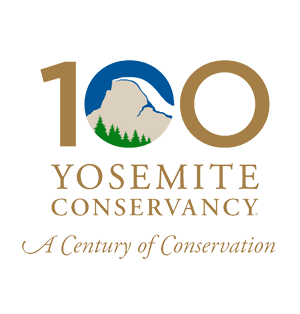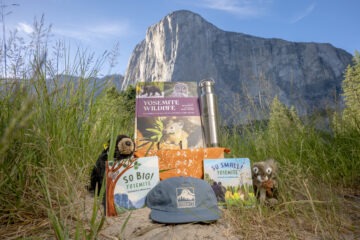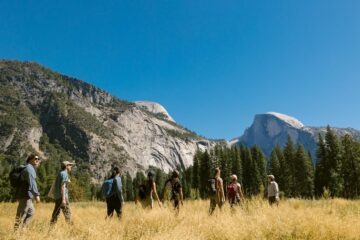Yosemite National Park is well-known for its expansive viewpoints, waterfalls, cliffs, and sequoias, and an extensive trail system. And yet, the intricate beauty of Yosemite — spring flowers, bears and bighorns, clean air, and healthy ecosystems — is made possible by a vibrant world of tiny pollinators.
Bees, butterflies, moths, wasps, and birds are all part of Yosemite’s pollinator population that help countless plant species flourish, which in turn radiates outward to maintain ecological balance within the park’s boundary and beyond. Continue reading to learn about the importance of these little creatures and how we can help care for them!
TL;DR
– The Buzz Behind Biodiversity
The Buzz Behind Biodiversity
Pollinators deserve a big thank you for their boundless contributions to life on Earth, because without them, many of the landscapes, species, and foods that we know and love might not exist.
Many pollinators feed on pollen and nectar, and as they travel from plant to plant, they inadvertently carry tiny grains of pollen with them. As it turns out, this transfer of pollen between plants is a crucial step in plant reproduction. In their own unique ways these small creatures live up to their name, pollinating each plant they visit and in turn helping entire plant communities thrive. In fact, without pollinators most flowering plants would die off.
These tiny pollinator friends facilitate the growth of the park’s diverse plant community — from the delicate wildflowers of Ackerson Meadow to the beauty of the pacific dogwoods in the Mariposa Grove. In Yosemite and beyond, this intricate connection between pollinators and plants trickles out to other parts of our world.
Plants supported by pollinators help a myriad of wildlife that depend on plants for food and shelter.
These pollinated plants also play an essential role in sustaining clean air, as strong plant communities help supply oxygen to the air we breathe while also removing carbon dioxide from the atmosphere.
Plants are also extremely helpful in supporting clean water and preventing erosion. Plants — especially in wetlands, forests, and streamside areas — act like natural filters, with their roots trapping sediments and breaking down pollutants. Plant roots also hold soil in place, reducing erosion, and preventing sediment from being washed into waterways.
The impact of healthy pollinators and plant communities extends throughout the natural world. So, it is in fact safe to say that life as we know it wouldn’t be the same without these tiny creatures.
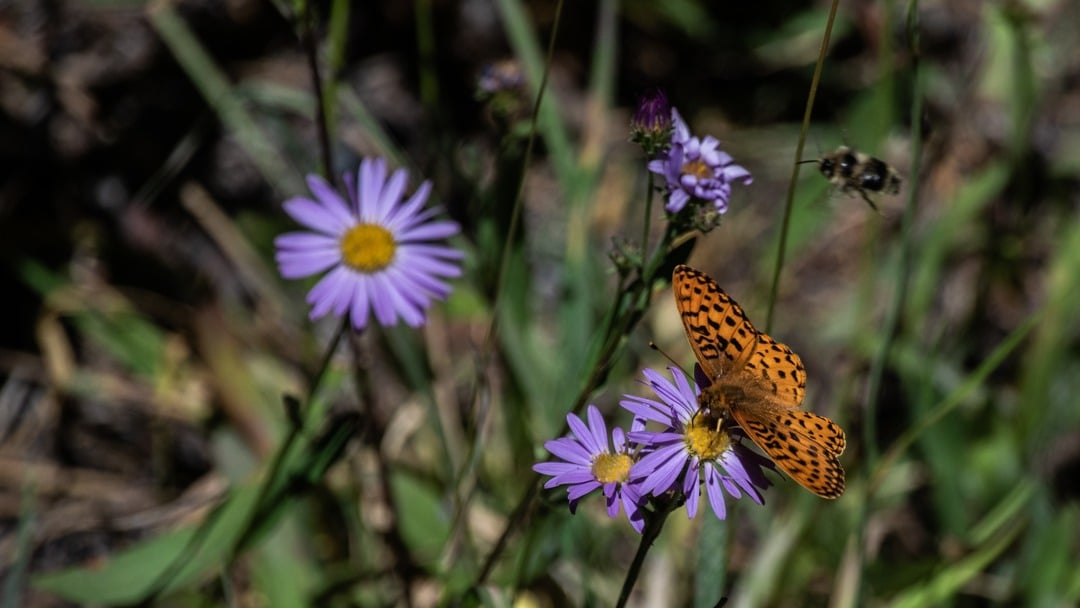
Two park pollinators — a bee and a butterfly — feast on purple flowers in eastern Yosemite. Photo by Henry Brening Photography.
Meet the Park’s Pollinators
Pollinators come in all shapes and sizes — many have wings, some are feathered, others are scaled, and a handful even have tails! Some of the most common pollinators you might find in Yosemite include bees, butterflies, moths, wasps, and birds, each very different in appearance, but all contributing greatly to the park’s ecosystems!
Bees
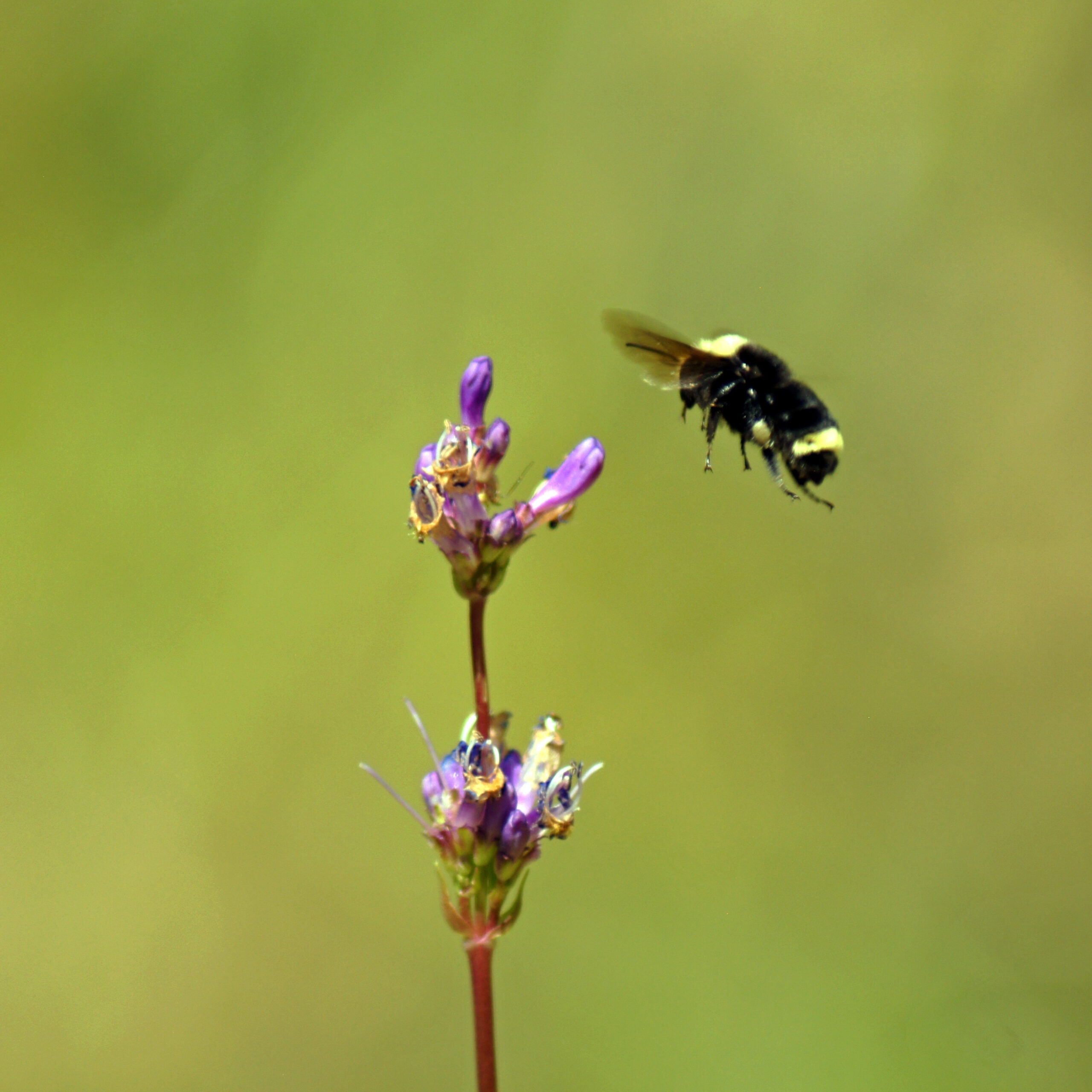
A bee approaches a native wildflower that was planted as part of pollinator habitat restoration work in Yosemite Valley. Photo courtesy of NPS.
Bees are some of the most efficient pollinators on Earth thanks to their anatomical features — pollen baskets and pollen-holding hairs — as well as their specialized pollination behaviors, including buzz pollination.
There are approximately 4,000 native species in the United States that depend on native plants. Yosemite is home to over 480 of these native bee species, making it one of the most bee-diverse areas in the Sierra Nevada. The park’s variety of elevations and habitats — from oak woodlands at 1,800’ above sea level to alpine meadows at 13,000’ — creates ideal conditions for the variety of busy bee pollinators in Yosemite.
While many of us know images of honeybees living and working together in a hive, the European honeybee is not native to North America. In fact, few native bees live and work communally like honeybees. Most of Yosemite’s bees are solitary bees. These solitary bees nest in holes in the ground or in crevices between rocks or bark, relying on a few species of flowering plants for survival.
For years, Yosemite Conservancy and the National Park Service partnered to care for the park’s bee species by working to understand how drought and rising temperatures are affecting plant communities in the park. In 2024, Conservancy donors funded the Yosemite Pollinator Hotshots project to create the first inventory of alpine bee pollinators in the Sierra Nevada. Teams found an incredible 6,000+ individual bees at 166 high country sites. .
Butterflies
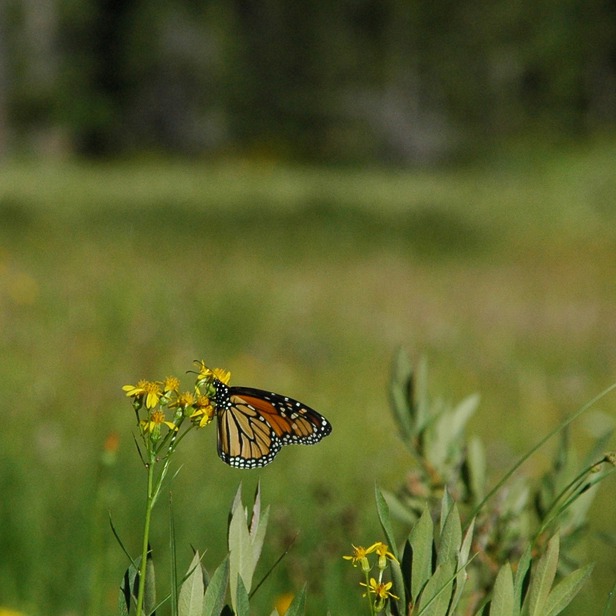
A monarch butterfly in Gin Flat Meadow, Yosemite National Park. Photo by Yosemite Conservancy/Ryan Kelly.
Another common winged pollinator in Yosemite are butterflies. Over 100 species of butterflies live in the park’s boundaries, many of whom thrive in Yosemite’s rugged alpine landscapes. These butterflies, along with various moth species, contribute significantly to pollination, especially for plants that bloom during twilight or nighttime hours.
Scientists have studied the parks’ butterflies since the 1930s, hoping to understand how environmental change affects this diverse species group. This includes the annual Yosemite Butterfly Count, which began in 2011 as a partnership between the National Park Service and the North American Butterfly Association.
Around the same time each year, dedicated scientists and volunteers gather in Tuolumne Meadows for a 24-hour period to record the number of species and individual butterflies they can find within a 15-mile diameter circle. Their findings year after year help park managers uncover important trends and changes in the distribution and population size of the park’s butterflies.
Wasps
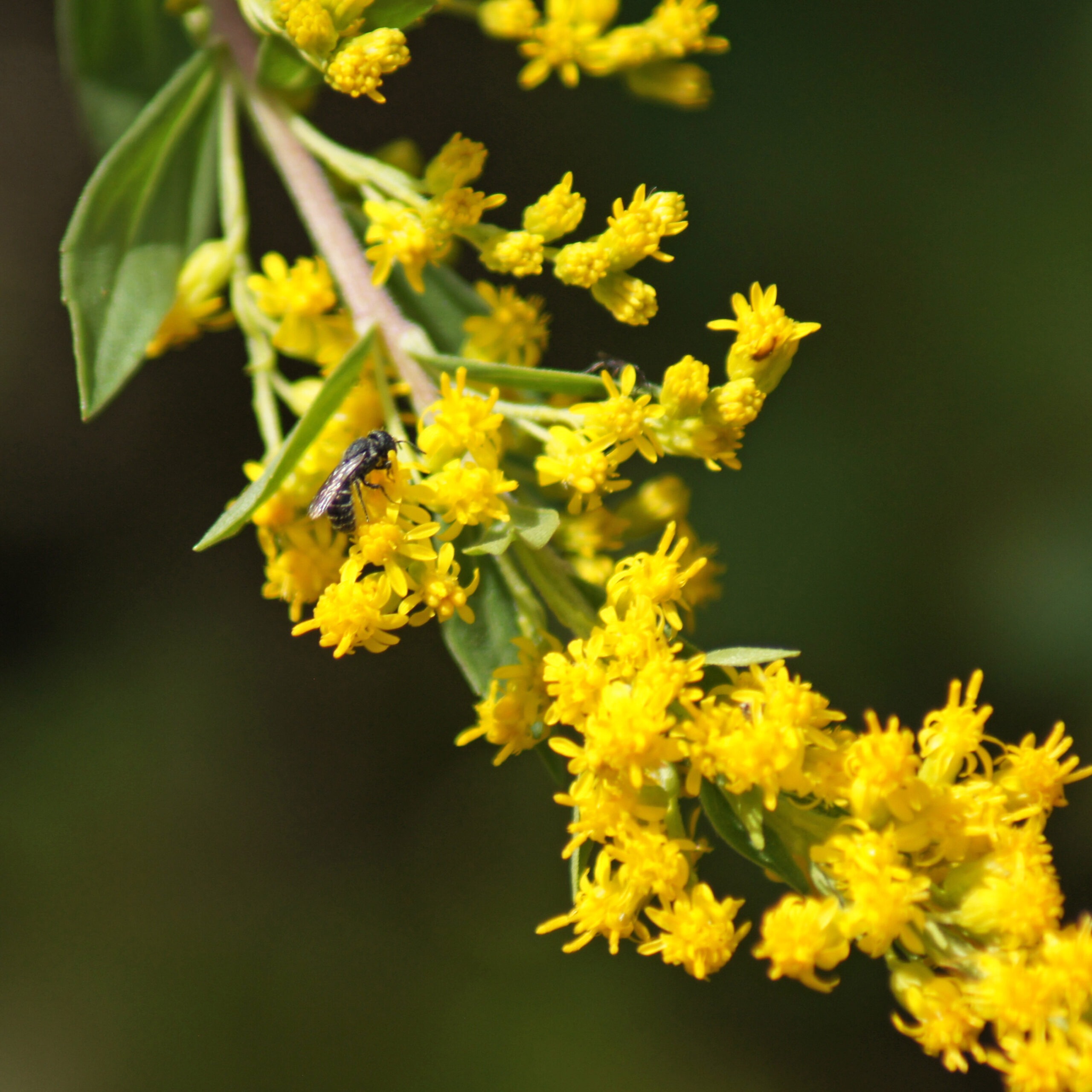
An insect on a native wildflower in Yosemite Valley. Photo courtesy of NPS.
Wasps are an important yet often overlooked part of Yosemite’s ecosystem. While they may have an intimidating reputation among human visitors, they actually play key roles as both predators and pollinators — helping control insect populations while also feeding off flower nectar.
In fact, their pollination activities support wildflowers and other plants that are commonly less visited by bees. So, we encourage you to hold a bit of appreciation for the next wasp you see (while still getting as far aways as possible!*).
* Yellowjackets are the wasp you’re most likely to encounter in the park. These insects are incredibly beneficial for plant populations and pest control, but they do pose minor threats to human visitors. Learn more about Yellowjackets on the NPS website.
Birds
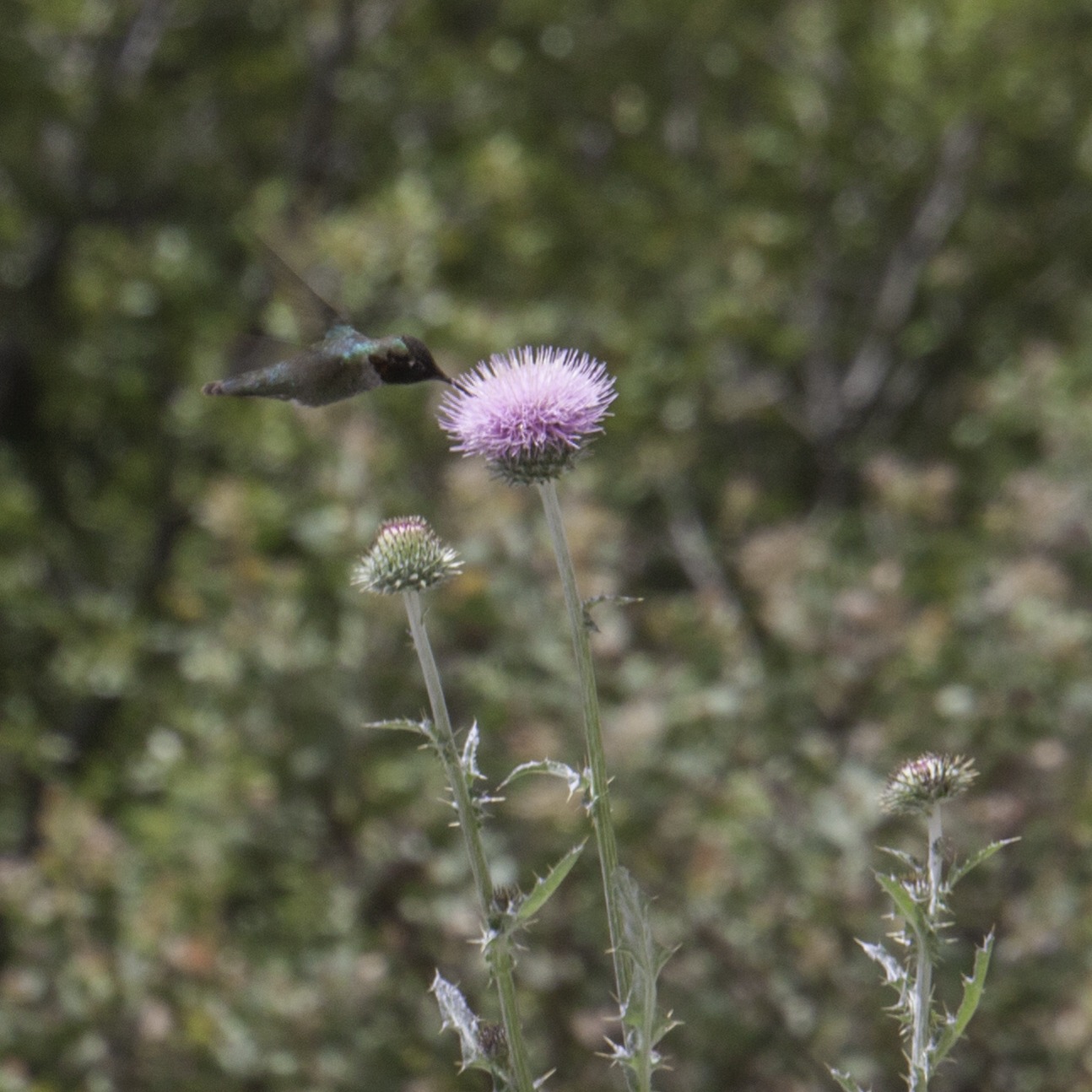
A hummingbird feeds on thistle near the edge of El Capitan. Photo by Yosemite Conservancy/Keith Walklet.
Beyond insects, certain bird species also support pollination in Yosemite — most notably, hummingbirds. These tiny, fast-moving birds feed on nectar from tubular flowers. As they feed on nectar-rich plants, pollen sticks to their heads and beaks, allowing them to unintentionally transfer them between the flowers of plants.
Ongoing research in Yosemite National Park (as part of the Pollinator Hotshots project) is helping park managers and biologists understand how these dynamic birds fit into the broader pollination network of the Sierra Nevada.
Learn more about the Pollinator Hotshots project here and learn about the monitoring of another special category of Yosemite birds, songbirds, here!
Threats to Pollinators
Pollinators are integral to the health and beauty of Yosemite National Park, but despite the importance of these tiny creatures in decline across the globe due to several natural and human-caused threats.
- Hotter Temperatures: Many plants rely on temperature as an indicator for when to flower. If temperatures get hotter, this can cause flowers to bloom before pollinators are present, meaning that there won’t be any creatures around to pollinate and help these plants grow/reproduce.
- Habitat Loss: Development and human activities can lead to the degradation and/or fragmentation of habitats that pollinators rely on for survival. Changes in temperature, severe storm frequency, drought, and light pollution are also causing shifts and damage to important habitats for pollinators.
- Pesticide Use: Exposure to certain chemicals can be harmful to pollinators. For one, some pesticides can affect the brains of pollinators like bees, butterflies, and other insects, which makes it harder for these creatures to perform normal functions like flying, locating flowers, or returning home. Other pesticides directly kill pollinators or their plant food sources.
These challenges underscore the importance of concerted conservation efforts to protect pollinators, and the need for increased awareness about the importance of these tiny creatures.
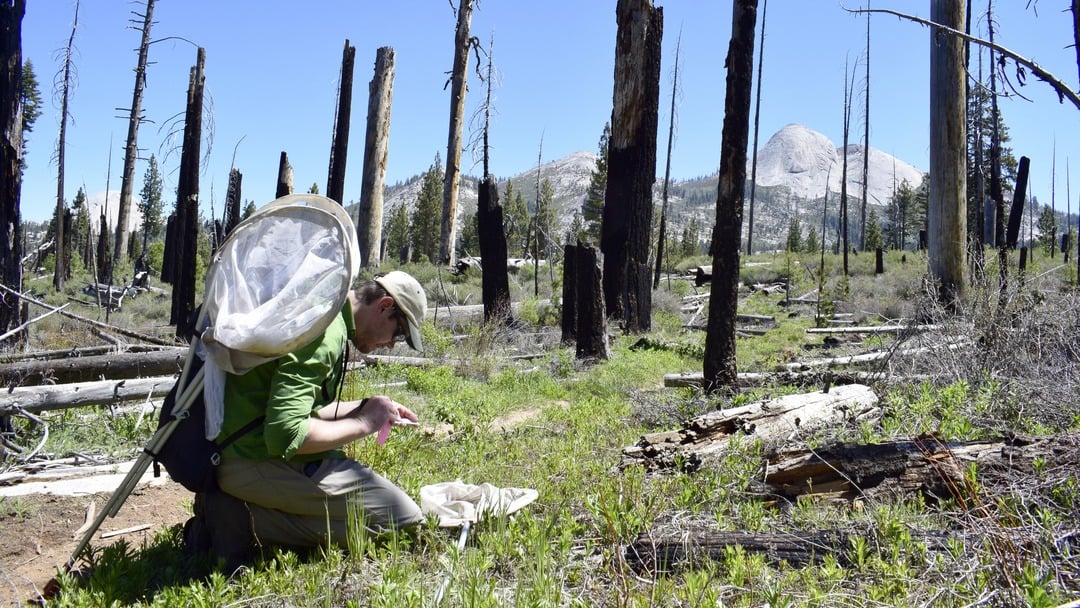
Butterfly researchers conduct field work on the Mono Meadows Trail, where the trees still show heavy burn scars from past wildfires. Photo by Yosemite Conservancy/Ryan Kelly.
How We Can Help
The dramatic decline in pollinator populations around the globe is definitely alarming, but it doesn’t mean that there isn’t anything we can do to help. Below are a handful of the ways that the Conservancy and the National Park Service (NPS) are partnering to protect pollinators, AND a list of actions you can take to care for them as well.
1. Restoring Native Habitat: One of the most effective ways to support pollinators is by restoring and protecting the native habitats they depend on. The Conservancy and the NPS work together to remove invasive species, reseed meadows, plant native plants, and more. By uplifting the health of these pollinator-friendly habitats, we help bees, butterflies, hummingbirds, and other pollinators find vital resources for survival.
What can you do? Planting native flowers and removing invasive plants from your garden can offer pollinators important sources of food and shelter. Likewise, an easy way to care for pollinators is by avoiding chemicals that are known to cause them harm.
2. Monitoring Populations: Protecting pollinators begins with understanding the status and historic trends of the park’s pollinator populations. Over the years, Conservancy donors have funded field surveys, citizen science programs, and advanced tracking tools used to collect data on species presence, abundance, and behavior. These efforts help us detect changes over time, allowing park managers to take proactive steps in protecting vulnerable pollinator species.
What can you do? Participate in citizen science! Many apps such as iNaturalist allow you to make observations of pollinators. These observations can help scientists have a better understanding of population and distribution.
3. Educating the Public: Raising awareness is a powerful tool in protecting pollinators. Educational programming and outreach can help people understand just how important these tiny creatures are to our ecosystems, food systems, and everyday lives. For years, the Conservancy and the NPS have worked together to make pollinator education available to park visitors. This has included interactive exhibits at visitor centers, workshops for schools and community groups, resources for teachers and families, and hands-on programs with park rangers — including the 2025 Ranger Buzz and Butterflies programs.
What can you do? Learning about park pollinators is one of the best ways to help care for these creatures. It can also help foster a connection between oneself and Yosemite’s intricate ecological web. So, if you’re visiting this summer, see if there are any Ranger Buzz and Butterflies programs in the park while you’re here. Hoping for a more hands-on approach? Check out the Conservancy’s work week program where volunteer groups spend a week at a time working on specific projects, including native seed collection.
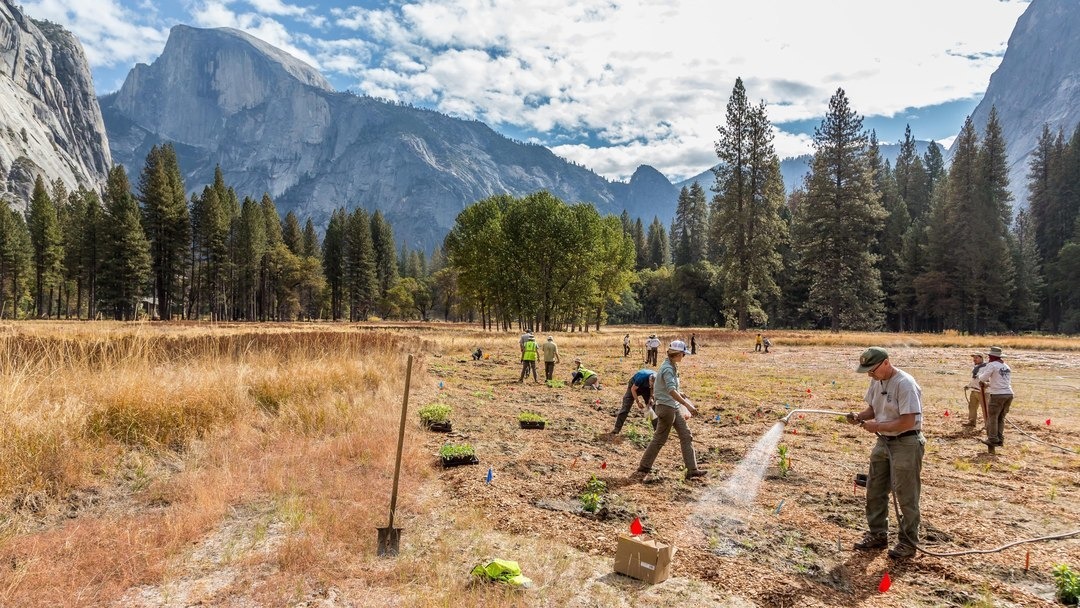
Work Week volunteers help out in Yosemite Valley on a Conservancy-funded project to improve habitat for pollinators. Photo by Terri Tipping.
Next time you find yourself in Yosemite National Park — or any outdoor space for that matter — take a moment to consider how pollinators have helped shape the landscape around you. We guarantee that even though they’re quite small, our pollinator friends have a BIG impact!
